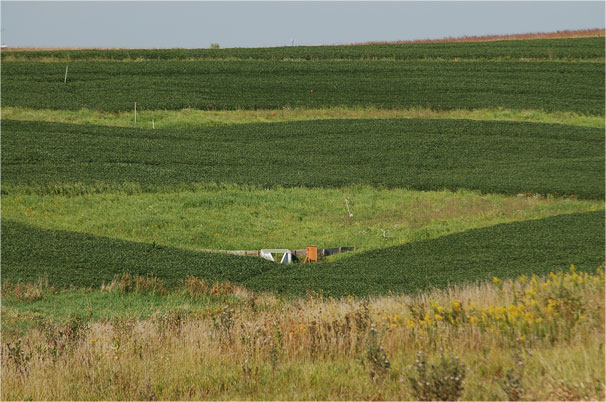Prairie strips offer solution to Midwest agriculture problems
By Ken Roseboro
Published: January 30, 2015
Category: Organic/Sustainable Farming

Prairie strips help to prevent soil erosion and fertilizer runoff into waterways while increasing wildlife habitat.
To access all the articles in this month's issue of The Organic & Non-GMO Report, SUBSCRIBE NOW.
Iowa State University’s STRIPS project reintroduces native prairie to Iowa, bringing with it benefits to soil, water, and biodiversity
An innovative project is using an age-old ecosystem to help solve problems resulting from modern agriculture. A team of scientists at Iowa State University is reintroducing strips of native prairie into Iowa’s farms as a way to reduce soil erosion, prevent fertilizer pollution of waterways, and create new habitats for wildlife, insects, and pollinators.
“Think outside the box”
The idea for the project arose out of discussions among agriculture experts at Iowa State who were becoming concerned about negative environmental impacts of industrial agriculture in Iowa, particularly with reduced water quality and loss of wildlife habitats.
“We were looking for something to do to address those concerns without impacting the profitability of agriculture,” says Lisa Schulte Moore, ISU associate professor of natural resource ecology and management. “We tried to think outside the box.”
Their idea was to reintroduce the once predominant ecosystem of Iowa—prairie—into Iowa’s farms, which are dominated by corn and soybean production.
Until the mid-1800s, Iowa’s landscape was dominated by prairie spreading across 85 percent of the state. But with the introduction of agriculture in the mid-19th century, Iowa’s prairie gave way to the plow and today just 0.1 percent of Iowa’s native prairie remains.
The ISU team, which included experts in agronomy, agricultural engineering, entomology, and ecology, chose the Neal Smith Wildlife Refuge in Prairie City, Iowa to conduct the prairie experiment. The 3,600-acre refuge contains the largest reconstructed prairie in Iowa.
Iowa is known for its rich, fertile soils, which resulted from centuries of growth and decay of tall prairie grasses with deep root systems.
As Moore says, “In Iowa you rarely see bare ground because the soil is so fertile.”
Reduced soil loss and fertilizer runoff, increased wildlife
The project, cleverly titled STRIPS (Science-based Trials of Rowcrops Integrated with Prairie Strips), began in 2007. Prairie strips were planted along with corn and soybeans on the refuge, particularly on slopes near watersheds, areas where water collects.
Researchers began documenting benefits in 2008. “We were able to measure responses right away,” says Moore who is the STRIPS communications lead. “The prairie strips were able to slow down water moving across farm fields, which can be erosive. It also kept nutrients in the field so they didn’t become pollutants in waterways, and there were increases in wildlife, birds, and insects.”
The STRIPS team found that converting just 10 percent of a crop field into perennial prairie can reduce soil loss by 95 percent, phosphorus loss by 90 percent and nitrogen loss by almost 85 percent. Soil loss, phosphorus, and nitrogen are three main causes of water pollution in Iowa. Excess nitrogen running off Midwest farms is also a leading cause of the “dead zone” that appears in the Gulf of Mexico each year. In terms of biodiversity, there was also a four-fold increase in native plant species, a doubling of bird species, and an increase of pollinators with the prairie strips.
Moore describes these as “disproportionate” benefits, meaning significant benefits can be realized by planting a just a small amount of prairie—and without impacting crop yields.
The benefits are starting to be backed by published research. A recent study published in the Journal of Environmental Quality found that prairie strips can remove nitrates, which pollute waterways, from cropland runoff over long periods of time.
Moore says she and her fellow researchers are excited about the possibilities of STRIPS.
“With some science projects, the results will just sit on a shelf,” she says. “But with this, we have a project where the science has legs, and it’s really exciting to be part of this.”
Strong farmer interest in STRIPS
For the next phase, the STRIPS team moved the project to farmers’ fields across Iowa to see if the benefits could be replicated.
There is strong interest among farmers in the project. “They are saying ‘I feel good about this practice,’” Moore says. “Farmers are interested in keeping soil on their lands and pollutants out of waterways.”
The first on-farm STRIPS project started in 2013; that grew to nine last year and will expand to 23 this year.
“This has been a good fit for a lot of farmers,” says Tim Youngquist, field coordinator for STRIPS, who works with the farmers. “They’ve known in their hearts that they want to do something to improve the land.”
Gary Guthrie, a farmer in Story County, Iowa, says he got “super excited” when he heard about the STRIPS project.
“Prairie strips fit with what we want to do, building diversity with insects and bees,” he says. “I’ve seen the result of soil devastation, and that informed my decision also.”
Guthrie will plant four, 30-foot-wide prairie strips this year on his 145-acre farm.
Farmers from neighboring states such as Nebraska, Minnesota, Michigan, the Dakotas, and Wisconsin are also inquiring about the project.
“We’re getting more interest than we can handle,” Youngquist says.
STRIPS is also getting national attention; food writer Mark Bittman recently praised the project in a column for the New York Times.
Ag and environmental groups find common ground on STRIPS
STRIPS is a rare initiative where opposite ends of the spectrum—conventional agricultural and environmental groups—find common ground. The Iowa Soybean Association and Iowa Corn Growers Association along with The Nature Conservancy and Iowa Environmental Council, as well as other state and regional groups, all support the project.
What is the long-term goal of STRIPS? The project’s team will continue to document the benefits and hopefully attract more farmers, who are key to its success.
“We would like that prairie strips become a common practice on farms across the Corn Belt,” Moore says.
According to one estimate, nearly one million acres of prairie strips could be planted in Iowa. Not a complete restoration but a huge improvement over 0.1 percent.
Obviously more needs to be done to address other problems with industrial agriculture, particularly with monocultures, pesticides, and GMOs. But the STRIPS project is demonstrating that sustainable solutions are available.
“We’ve got a chance to make Iowa a better place, one field at a time,” Youngquist says.
© Copyright The Organic & Non-GMO Report, February 2015




